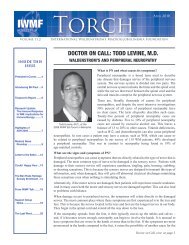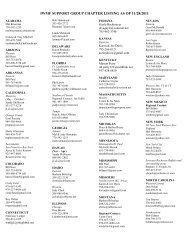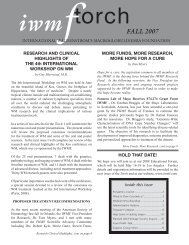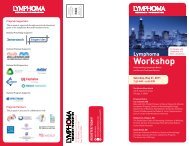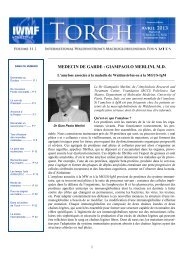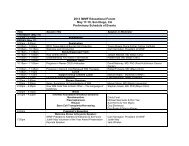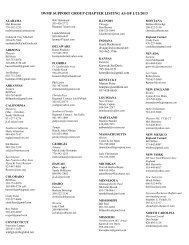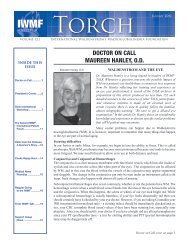English - International Waldenstrom's Macroglobulinemia Foundation
English - International Waldenstrom's Macroglobulinemia Foundation
English - International Waldenstrom's Macroglobulinemia Foundation
Create successful ePaper yourself
Turn your PDF publications into a flip-book with our unique Google optimized e-Paper software.
COOKS’ HAPPY HOUR<br />
b y Penni Wisner<br />
Everyone always wants to know how to eat more healthfully.<br />
It should be simple but so many voices have so much advice<br />
that confusion results. This spring, as fresh vegetables and<br />
fruits reappear in the markets, is as good a time as any to recall<br />
Michael Pollan’s seven word summation that will take you<br />
immediately toward your goal of a healthy diet (provided that<br />
is your goal): Eat food, not too much, mostly plants. (Thank<br />
goodness cocoa is a plant!)<br />
Food, by his definition, is anything your grandmother would<br />
recognize as food. And/or anything with only five, easily<br />
recognized ingredients on its label. There are exceptions, of<br />
course, for instance those new, “super” yogurts with ten active<br />
cultures when each is listed as a separate ingredient.<br />
In 2012 I participated in several nutrition-and-demonstration<br />
presentations for cancer groups. A registered dietician would<br />
give the lecture while I did the fun part—made the food that<br />
brought all those concepts and theories to tasty life.<br />
As the lecturers made their points I looked over the vegan<br />
buffet laid out for the participants. Eat vegetables: bowls of<br />
them lined up ready to stuff veggie wraps. Eat plenty of leafy<br />
greens: kale chips with coconut and nutritional yeast. Whole<br />
soy. Organic edamame beans. Whole grains: whole-wheat<br />
flatbread and quinoa. Nuts and seeds: yup, roasted pumpkin<br />
and sunflower seeds. Omega-3 sources: sure, flax meal and<br />
chia seeds. Antioxidants: check! Colorful fruit and dark<br />
chocolate. Homemade salad dressings for those who preferred<br />
to turn all those vegetables into a salad instead of a sandwich<br />
stuffing. And gluten-free wrap alternatives: rice paper wraps,<br />
nori sheets, and collard leaves. (I will describe those in more<br />
detail later.)<br />
For people like us WMers, a diverse and fascinating group<br />
(don’t you think so?), our primary concern (I am making<br />
assumptions but I hope you will agree with them) is to increase<br />
or maintain energy levels and to, if possible, prevent or delay<br />
recurrences. This is best done by following Pollan’s commonsense<br />
advice. (Can you tell he’s my hero?)<br />
Nutritionists tell us to eat five (1/2-cup) servings of vegetables<br />
per day. To divide our plates in fourths and cover half with<br />
vegetables, one-quarter with protein, and the remaining<br />
quarter with whole grains. I ask you: Does this sound fun?<br />
Delicious? Easy?<br />
My first line of attack to solve the “eat more vegetables” case is:<br />
Attitude. Eat your vegetables raw. Exceptions allowed: Vegetables<br />
you cannot digest and mushrooms, which must be cooked. Raw<br />
zucchini is sweet and crisp. Baby butternut squash is tender. Raw<br />
beet has less “beet-iness” than cooked beets and is very crunchy.<br />
Those who live around the Mediterranean (that hotbed of healthy<br />
diets) eat thinly sliced, raw artichokes. Now that asparagus season<br />
is upon us, slice it very thin and eat it raw. Unless you cannot<br />
digest them, eat fava beans raw. You get it, right?<br />
The second best way to deal with stacks of vegetables is<br />
with good equipment: a very sharp chef’s knife, a hand-held<br />
mandolin/slicer, a hand-held julienne slicer, and a spiral slicer<br />
(Benriner is the manufacturer of the one I have but new ones are<br />
just being released). With all, you must watch your fingertips.<br />
Otherwise, these tools help you slice, dice, and julienne quickly<br />
and evenly. The spiral slicer fascinates seminar members<br />
every time because it turns carrots, cucumbers, zucchini,<br />
beets, and radishes (to name a few) into thin, curly threads.<br />
A little vinaigrette (homemade, remember?) and you have an<br />
amazing salad.<br />
Luckily, it is becoming easier and easier to eat in a healthy<br />
manner. For example, while shopping for a cancer-survivor<br />
retreat day, I found fresh, organic pea and radish sprouts at<br />
Trader Joe’s. Look at sprouts as “the little engines that could,”<br />
seeds developing their full potential––growing. Therefore,<br />
when your onions and garlic sprout, cook those little green<br />
shoots. On the other hand, divide and plant, do not eat,<br />
sprouted potatoes!<br />
For one event, I sprouted some organic dried chickpeas. All<br />
it took was an overnight soak and then leaving the drained<br />
chickpeas on paper towels (so they remain humid) in a covered<br />
container for a day. (Eat the sprouts when the growing tip is<br />
only about 1/4-inch long.) You can eat them without further<br />
cooking or roll them in spices, herbs, and oil and bake them<br />
until crispy for a cocktail snack. Or make hummus with them.<br />
Sprout wheat berries the same way and cook them into cereal—<br />
the sprouting process has the added benefit of shortening the<br />
cooking time—or use them for grain salads, as a salad add-in,<br />
or in breads and muffins.<br />
Trader Joe’s also offers bags of chia seeds, the new omega-3<br />
super star on the grocery aisle. They joined their brothers in<br />
omega-3 land, flax seeds, which have been on shelves for<br />
some time. Bob’s Red Mill sells flax meal but I prefer the oily<br />
richness of freshly ground seeds to the convenience of the<br />
meal. How to use these nutrition boosters? Since the events<br />
were buffet lunches, the chia seeds and flax meal were there<br />
as veggie-wrap add-ins as well as salad toppers. Or add them<br />
to bread and muffin batters, as toppings for salads and soups.<br />
Or just let them soak in a glass of water until it gels. A sort of<br />
omega-3 bubble tea!<br />
When I demonstrated using collard leaves as wraps instead<br />
of bread, they gained an enthusiastic audience. It’s the same<br />
idea as using grape leaves. Now that I think of it, stuffed grape<br />
leaves are a wonderfully healthy snack to take out to watch<br />
the sunset with your glass of wine. To make the collard wraps,<br />
choose the biggest leaves you can. Trim the collard stems at the<br />
base of the leaves. And then shave the stem on the underside of<br />
the leaf to get it as thin as possible. Finally, blanch the leaves,<br />
one by one, in a large shallow skillet of salted water for 30<br />
Cooks' Happy Hour, cont. on page 23<br />
22 IWMF TORCH Volume 14.2





